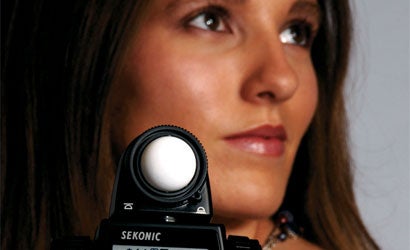Review: Sekonic L-758DR DigitalMaster Lightmeter
The new Sekonic L-758DR DigitalMaster lightmeter gives you precision when it counts most.

We may earn revenue from the products available on this page and participate in affiliate programs. Learn more ›
How do fine-art and pro shooters get beautiful, full-tone images with satisfying highlight and shadow detail? They use exposure systems that carefully mate the dynamic ranges of input and output variables. Especially now, with the notoriously narrow exposure latitudes of digital sensors, it’s the only way to consistently produce full-tone images.
For any of these systems, step one is accurate metering — which brings me to the Sekonic L-758DR DigitalMaster lightmeter ($500, street). The first designed for digital capture, it’s more than just a meter. It uses analytical software, a special test target, and USB connectivity to your computer to help you set precise exposure. You can profile the L-758DR to display the highlight-toshadow dynamic range of up to three specific DSLRs for flash, ambient, reflective, and incident readings.
Over a six-week period, I profiled three different DSLR sensors: those on the Canon EOS 30D, Fujifilm FinePix S3 Pro, and the Nikon D80. The meter has both pitfalls and peaks.
The process starts with making four exposure brackets of a special nine-tone gray scale target. The resulting files are read in Adobe Photoshop’s Info palette to determine the true native ISO of the sensor (i.e., which exposures will reproduce an 18% gray file — that’s an 118% Green RGB reading — from an 18% gray test target).
The brackets are then analyzed in Sekonic’s profiling software to determine the sensor’s latitude across a full range of ISOs. That latitude is downloaded to the meter, which thereafter alerts you whenever highlights or shadows exceed the sensor’s ability to capture them.
Over the weeks of my tests, it became clear that the rather complex profiling procedure is poorly explained (or translated) in the L-758DR’s manual. Another limitation: As of this writing, the profiling software isn’t compatible with Windows Vista or Mac Intel machines. Software and instruction manual upgrades are promised.
| Additional Features• Four metering modes: ambient, flash, reflective, incident • Built-in wireless triggering for PocketWizard compatible strobes • Readouts in EV levels, apertures, and/or shutter speeds • 1-degree Spot meter with viewfinder readouts • Flash/Ambient analysis • Exposure compensation • User calibration • Memorization and averaging of up to 9 readings • 14 Custom Functions • Weather resistant |
These caveats aside, the meter won me over. One reason: Of the three DSLR sensors I profiled, none was successfully calibrated to its own built-in metering system. They couldn’t reproduce files with 18% RGB readouts from an 18% gray target, but were off by between 1/3 and 2/3 stops in the Evaluative/Matrix metering modes. Precise exposures require a more refined system.
I was also surprised to discover how unreliable the LCD monitors on all three of my profiled DSLRs were for exposures. Setting exposures based on what looked best on the LCD screen produced uniformly overexposed files, with noticeable losses in highlight detail. (With critical work, histograms are of limited help, as they alert you — after exposure — to lost detail, but not to where in a scene the detail is lost.)
Conversely, shooting the same subject with exposures based on the meter’s suggested settings (after profiling) produced images that appeared slightly underexposed on the LCD screen, but when opened in Photoshop, they contained significantly more highlight detail, with minimal loss in the shadows.
If you’re super-serious about precise exposure metering with your DSLR, the Sekonic L-758DR is clearly worth a look.